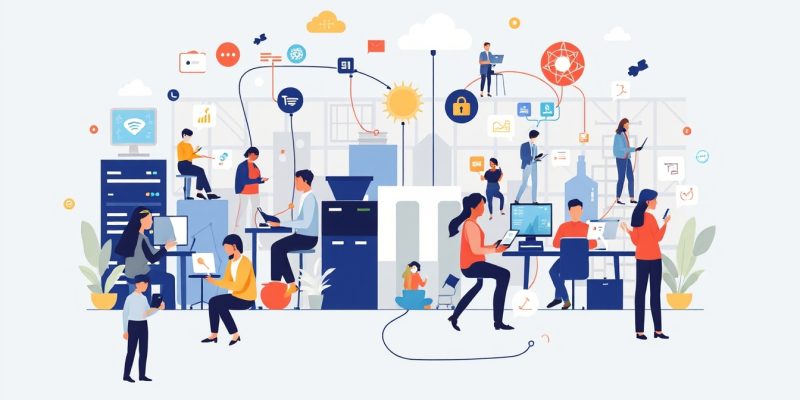In the rapidly evolving digital landscape, Information Technology (IT) plays a pivotal role in the functioning of businesses, government, education, and daily life. It encompasses a wide array of technologies and practices that enable the creation, storage, retrieval, and dissemination of information. This article explores the definition of IT, its components, significance, current trends, and what the future holds for this dynamic field.
What is Information Technology?
Information Technology refers to the use of computers, software, networks, and other digital devices to manage and process information. It involves the development, implementation, and management of computer-based information systems and encompasses everything from software applications and database management to network infrastructure and cybersecurity.
Key Components of IT
- Hardware: This includes the physical devices and equipment used in information processing, such as computers, servers, networking devices (routers, switches), and storage devices.
- Software: Software encompasses the applications and programs that run on hardware, including operating systems (e.g., Windows, macOS, Linux), productivity tools (e.g., Microsoft Office, Google Workspace), and specialized applications (e.g., CRM software, accounting systems).
- Networks: Networking involves the connection of computers and devices to share resources and information. This includes local area networks (LANs), wide area networks (WANs), and the internet, which enables communication and data exchange on a global scale.
- Databases: Databases store and manage data, allowing for easy access, retrieval, and analysis. Database management systems (DBMS) like MySQL, Oracle, and Microsoft SQL Server are crucial for handling large volumes of information.
- Cybersecurity: As cyber threats increase, cybersecurity has become a critical component of IT. It involves protecting systems, networks, and data from unauthorized access and attacks through measures like firewalls, encryption, and intrusion detection systems.
- Cloud Computing: Cloud technology enables the storage and access of data and applications over the internet instead of on local servers. It offers scalability, flexibility, and cost-effectiveness for businesses and individuals.
The Importance of Information Technology
- Business Efficiency: IT streamlines processes and enhances productivity by automating tasks, facilitating communication, and providing tools for data analysis and decision-making.
- Data Management: Organizations rely on IT to collect, store, and analyze vast amounts of data. This data-driven approach helps businesses understand customer preferences, market trends, and operational efficiency.
- Communication: IT enables instant communication through emails, messaging platforms, and video conferencing tools, fostering collaboration among teams and clients regardless of geographical locations.
- Innovation and Development: IT drives innovation by providing the tools and infrastructure necessary for research, development, and the creation of new products and services.
- Accessibility: Information technology has made information and services more accessible to people worldwide. The internet, e-commerce, and digital platforms allow users to access resources and services from anywhere at any time.
Current Trends in Information Technology
- Artificial Intelligence (AI) and Machine Learning: AI and machine learning are revolutionizing how businesses operate, enabling automation, predictive analytics, and enhanced decision-making.
- Big Data and Analytics: The ability to analyze large datasets is transforming industries by providing insights that drive business strategies and improve customer experiences.
- Internet of Things (IoT): IoT connects everyday devices to the internet, allowing for real-time data collection and remote control. This technology is reshaping industries such as healthcare, agriculture, and smart home solutions.
- Blockchain Technology: Blockchain provides a secure and transparent way to record transactions, making it a popular choice for industries such as finance, supply chain management, and healthcare.
- Remote Work Technology: The rise of remote work has increased demand for IT solutions that support virtual collaboration, including cloud storage, project management tools, and communication platforms.
The Future of IT
The future of Information Technology is poised for exciting advancements and changes. Here are some predictions for the coming years:
- Increased Integration of AI: As AI technology continues to evolve, we can expect more sophisticated applications in various sectors, improving efficiency and decision-making processes.
- Enhanced Cybersecurity Measures: With the rise in cyber threats, businesses will increasingly invest in advanced cybersecurity measures, including AI-driven security solutions and zero-trust architectures.
- 5G Technology: The rollout of 5G networks will enhance connectivity, enabling faster data transfer and supporting the growth of IoT devices and applications.
- Sustainable IT Practices: As environmental concerns grow, there will be a shift toward sustainable IT practices, including energy-efficient data centers, e-waste recycling, and green computing initiatives.
- Evolving Workforce Dynamics: The IT workforce will continue to evolve, with a greater emphasis on remote work capabilities, cross-disciplinary skills, and continuous learning to keep pace with technological advancements.
Conclusion
Information Technology is a fundamental aspect of modern society, influencing how we communicate, work, and interact with the world. As technology continues to advance, the role of IT will only grow more significant. By understanding the components, importance, trends, and future of IT, individuals and organizations can better position themselves to leverage technology for success in an increasingly digital landscape. Embracing these changes will be crucial for staying competitive and innovative in today’s fast-paced world.
This article provides an overview of Information Technology, emphasizing its significance and the trends shaping its future, making it a valuable resource for readers interested in understanding IT’s impact on society and business.
